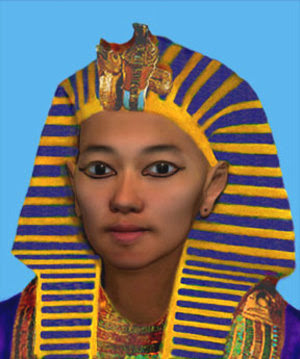

| Online: | |
| Visits: | |
| Stories: |

| Story Views | |
| Now: | |
| Last Hour: | |
| Last 24 Hours: | |
| Total: | |
What Did King Tut Really Look Like?
**This is a special guest post by one of my favorite researchers and artists in the field of ancients and Bigfoot, David Claerr**
In the past decade, the mummy of the boy Pharaoh, Tutankhamun, commonly referred to as King Tut was exhumed and scanned using medical imaging equipment that gives a detailed virtual 3d image. The data from the scan was be used to make solid resin casts of the mummified skull in one-to-one scaled dimensions.
Artists were commissioned to re-create a sculptured likeness of King Tut, adding clay to the cast skull for the likenesses which were then cast in various materials such as silicon. Although tissue-thickness data was used in the reconstruction, the results were regarded by many as inaccurate and disappointing. The several likenesses created by forensic artists varied significantly from one to another, and, more importantly, they lack resemblance to the sculptured portraits of King Tut by the most talented artists of his day. Some of the reconstructions resembled modern Europeans more than the Caucasoid Asiatic Egyptians of Tut's era.
In addition to the well-known gold funerary masks and coffins of King Tut, several painted-sculpture portraits are in existence that much more closely resemble his true likeness. Although the ancient sculptured portraits could have slight differences in artistic style, the most realistic were likely modeled from sessions with Tut himself posing, and they incorporate individual characteristics that can be recognized from sculpture to sculpture. There are several of busts of Tutankhamun that are included this category.
The facial features and bone structure of the mummy of Tutankhamun show a close correlation to the sculptures of the boy Pharaoh. Congruent characteristics include pronounced cheekbones, and large eye orbits with elevated, arching brow lines. The bridge of the nose is shallow and slender, and it widens to a broad base with a rounded tip. The jawline tapers to a relatively small, recessive chin. These genetic features are shared by Tut, his father, Akhenaten, his mother, Kiya, and his sisters. (Please refer to image links in the Resources section below.)
The accompanying image to this article is a computer-generated and digitally illustrated image of King Tut The image, by the author, portrays Tutankhamen at age fifteen, just prior to his early death. Tut's fabric headdress is called a nemes, most likely comprised of dyed linen with gold brocaded stripes. The diadem on his forehead is mounted on band of gold. The sculptures on the diadem are the royal vulture and cobra icons, comprised of gold, inlaid with the semi-precious stones of deep blue lapis lazuli, red carnelian, and blue-green turquoise . The same materials were employed in the magnificent beaded yoke which Tutankhamun wears about his chest and shoulders.
Resources:
Treasures of King Tutankhamun
Ballantine Books, New York 1976
ISBN 0-345-27349-4
Brace et al. (1993). 24 sets of craniofacial measurement comparisons made on mummified skeletal remains from Egypt, Nubia, India, Somali, North Africa, Europe,Asia,and North America. Selected measurements were those known to be genetically controlled . Conclusions were that ancient Egyptians are most closely genetically related to the populations of South Asia, neolithic Europe and Northern Africa. (refer to Brace et al. [1993] for complete list).
Sculptures of Tutankhamen by his contemporaries
http://www.stewartsynopsis.com/images/tutface505.jpg
http://www.jasoncolavito.com/uploads/3/7/5/9/3759274/4710154_orig.jpg
https://img0.etsystatic.com/057/1/9566914/il_340x270.709074232_8isn.jpg
ABOUT THE AUTHOR: David Claerr is an avid researcher of Bigfoot, ancient giants, anthropology and archaeology, as well as a talented artist. You can find his books on Amazon (LINK) and his personal design site with beautiful posters (LINK) in the link locations.
Source: http://www.ghosthuntingtheories.com/2016/03/what-did-king-tut-really-look-like.html



